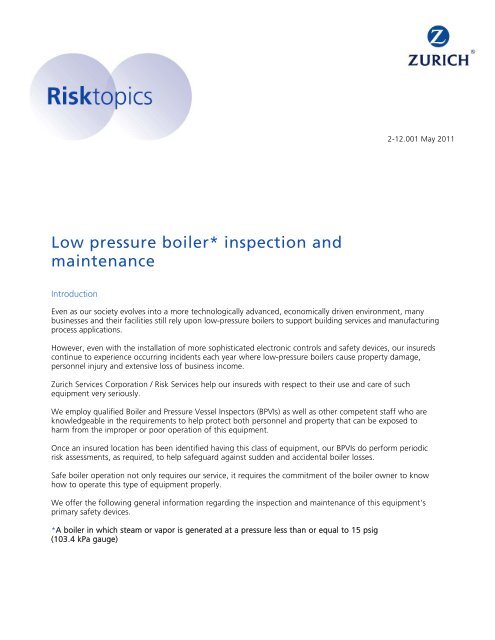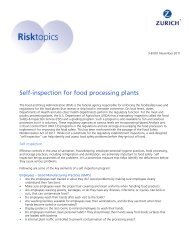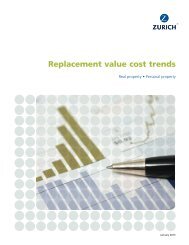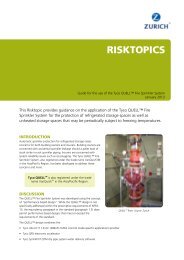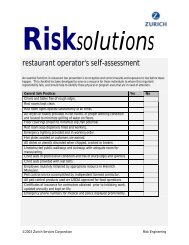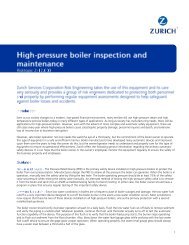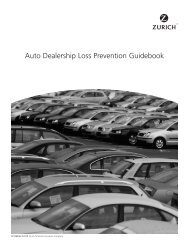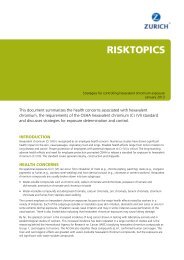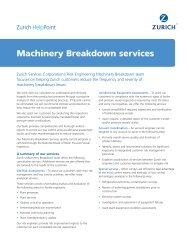Low pressure boiler* inspection and maintenance - Risk Engineering
Low pressure boiler* inspection and maintenance - Risk Engineering
Low pressure boiler* inspection and maintenance - Risk Engineering
You also want an ePaper? Increase the reach of your titles
YUMPU automatically turns print PDFs into web optimized ePapers that Google loves.
2-12.001 May 2011<br />
<strong>Low</strong> <strong>pressure</strong> <strong>boiler*</strong> <strong>inspection</strong> <strong>and</strong><br />
<strong>maintenance</strong><br />
Introduction<br />
Even as our society evolves into a more technologically advanced, economically driven environment, many<br />
businesses <strong>and</strong> their facilities still rely upon low-<strong>pressure</strong> boilers to support building services <strong>and</strong> manufacturing<br />
process applications.<br />
However, even with the installation of more sophisticated electronic controls <strong>and</strong> safety devices, our insureds<br />
continue to experience occurring incidents each year where low-<strong>pressure</strong> boilers cause property damage,<br />
personnel injury <strong>and</strong> extensive loss of business income.<br />
Zurich Services Corporation / <strong>Risk</strong> Services help our insureds with respect to their use <strong>and</strong> care of such<br />
equipment very seriously.<br />
We employ qualified Boiler <strong>and</strong> Pressure Vessel Inspectors (BPVIs) as well as other competent staff who are<br />
knowledgeable in the requirements to help protect both personnel <strong>and</strong> property that can be exposed to<br />
harm from the improper or poor operation of this equipment.<br />
Once an insured location has been identified having this class of equipment, our BPVIs do perform periodic<br />
risk assessments, as required, to help safeguard against sudden <strong>and</strong> accidental boiler losses.<br />
Safe boiler operation not only requires our service, it requires the commitment of the boiler owner to know<br />
how to operate this type of equipment properly.<br />
We offer the following general information regarding the <strong>inspection</strong> <strong>and</strong> <strong>maintenance</strong> of this equipment's<br />
primary safety devices.<br />
*A boiler in which steam or vapor is generated at a <strong>pressure</strong> less than or equal to 15 psig<br />
(103.4 kPa gauge)
Pressure relief devices (PRD’s) **<br />
The Safety Valve (SV) is the primary safety device installed on any low-<strong>pressure</strong> boiler to protect it against over<br />
pressurization. Manufacturers design <strong>and</strong> build the SV to relieve all of the <strong>pressure</strong> the boiler can generate.<br />
When a boiler is in operation, the operator or competent person in charge can manually test the SV operation<br />
by lifting its test lever. The boiler operating <strong>pressure</strong> should be at least 75% of the safety valve set <strong>pressure</strong><br />
when testing the safety valve manually. An alternate method of testing the low-<strong>pressure</strong> boiler SV is to remove<br />
it from the boiler during the annual scheduled <strong>maintenance</strong>/service period <strong>and</strong> send it to an ASME (VR)***<br />
accredited testing facility for bench testing <strong>and</strong> re-certification before re-installation. Either verification test<br />
method is acceptable. The boiler owner needs to have this service incorporated into a proper boiler<br />
preventative <strong>maintenance</strong> program to ensure regular testing of this important safety device.<br />
** Commonly referred to as a Safety Valve or Safety Relief Valve depending upon its intended service.<br />
*** American Society of Mechanical Engineers, Valve Repair<br />
<strong>Low</strong> Water Fuel Cut-Off (LWFCO)<br />
Because low water conditions in a boiler can result in internal damage or even catastrophic failure, the<br />
LWFCO is a very important safety device designed to cut off the fuel supply to the boiler in the event a low<br />
water condition. Most jurisdictional authorities (State <strong>and</strong> Provincial) now require that there be two of these devices<br />
installed on all low-<strong>pressure</strong> boilers, one as the primary protection with a secondary backup device.<br />
The Primary LWFCO when manually drained will shut off the fuel supply to the boiler, temporarily shut down the<br />
boiler air supply fan <strong>and</strong> start the feedwater pump. Upon closing the drain valve <strong>and</strong> the water level is returned to<br />
normal, the air supply fan will automatically restart to purge the boiler gas side before the fuel firing system will be<br />
energized to resume normal operation. A minimum of four boiler gas passage air exchanges is typically required<br />
before the automatic fuel valves can be energized to operate.<br />
The Secondary LWFCO when manually drained will shut off the fuel supply to the boiler, shut down the boiler air<br />
supply fan <strong>and</strong> the feedwater pump will remain shut off. Only when the manual drain valve is closed <strong>and</strong> the<br />
LWFCO is manually reset, as per the manufacturers operating instructions, will the pre-purge <strong>and</strong> auto firing<br />
sequence resume after the feedwater pump starts to supply the proper water level within the boiler.<br />
In both tests an audible alarm at the boiler <strong>and</strong> a remote alarm sounds (unattended plants) which will have to be<br />
reset at the boiler operating panel.<br />
Simply open the lower water side drain below the float chamber or probe column. The flame failure should occur<br />
almost immediately when the water level drops. Close the drain valve once flame failure is confirmed visually <strong>and</strong><br />
by alarm. By keeping the inside of the float or column piping <strong>and</strong> chamber clean, this test will maintain these<br />
devices in good operating condition.<br />
This manual testing can be done daily or no less than once per week depending upon the critical nature of the<br />
steam process <strong>and</strong> dem<strong>and</strong>. The results are to be logged in the Operators Log Book for review.<br />
The benefit from doing this manual test regularly is that you are forcing the water <strong>and</strong> any sediment out while<br />
verifying that the steam <strong>and</strong> water side piping <strong>and</strong> connections are not obstructed. If the piping is clear this test<br />
should take no more than five seconds. Additionally this effectively tests the automatic function capability of both<br />
safety devices.<br />
Periodically the water level gauge glass needs to be blown down on the Primary LWFCO device to ensure the gage<br />
glass' proper operation. When operating properly, the water level gauge glass should always have a water level<br />
between a third <strong>and</strong> a half of the glass. NOTE: the boiler fuel system should shut down before the water level drops<br />
below the lowest visible point in the glass.
Burner operation – Flame failure scanner<br />
To prevent boiler fireside explosions, the boiler owner/operator must verify that some type of flame-sensing device is<br />
in use to ensure that flame conditions are safe on the boiler burner side. In the event of flame failure during<br />
operation, the flame-sensing device must be capable of stopping the boiler fuel supply, initiating an alarm <strong>and</strong> causing<br />
an air purge of the boiler fireside passes to remove latent fuel fumes from the boiler's fireside.<br />
Check the burner operation <strong>and</strong> flame pattern regularly <strong>and</strong> flame failure scanner periodically, preferably at least<br />
weekly. In general, listen for unusual noise, check for fuel leaks, check the position of dampers, <strong>and</strong> look or smell for<br />
indications of flue gas leakage. Observe the boiler stack temperature to verify it is within the normal operating<br />
range. Follow the boiler manufacturer’s guidelines <strong>and</strong> the ASME CSD-1 Code for burner <strong>maintenance</strong> <strong>and</strong> testing of<br />
the flame failure scanner. If the burner shows any indications of abnormal operation, contact your boiler service<br />
technician.<br />
Boiler steam gauge<br />
The boiler steam gauge allows the boiler operators to see how much <strong>pressure</strong> the boiler is generating. Steam<br />
gauges should be clearly visible <strong>and</strong> in good operating condition. The gage shall be connected to the boiler<br />
steam space or to its water column or its steam connection. The gage or gage connection shall contain a siphon<br />
or equivalent device that will develop <strong>and</strong> maintain a water seal that will prevent steam from entering the gage<br />
tube.<br />
The scale on the dial of a steam boiler gage shall be graduated to not less than 29 psig (200 kPa) or more than<br />
58 psig (400 kPa). The travel of the pointer from 0 psig (0 kPa) to 29 psig (200 kPa) <strong>pressure</strong> shall be at least 3<br />
in. (76 mm).<br />
High limit controls<br />
Each boiler must have high limit controls installed. These devices will act as a backup control to the normal<br />
operating controls. On a low-<strong>pressure</strong> steam boiler, there will be an Operating Limit Switch set to have the boiler<br />
burner fire when the steam <strong>pressure</strong> drops to a predetermined low set point <strong>and</strong> then cut off when <strong>pressure</strong><br />
reaches a predetermined high set point. If steam <strong>pressure</strong> exceeds the Normal Operating Pressure range of low -<br />
high, the High/High Limit Control Switch is designed to send a signal to the boiler controls that will stop fuel flow<br />
<strong>and</strong> cut the boiler off, similar to the flame failure scanner. Have a qualified technician test these devices during any<br />
scheduled <strong>maintenance</strong> period to ensure the proper signals are being received at the normal device set points.<br />
Conclusion<br />
There are other devices used on low-<strong>pressure</strong> boilers that are very important to the boiler's safe <strong>and</strong> efficient<br />
operation – temperature gauges, <strong>pressure</strong> gauges, air/fuel supply controls <strong>and</strong> linkages, fuel shut off valves, strainers,<br />
feedwater pump/motor, bearing cooling, isolation valves, main steam outlet valve, manhole <strong>and</strong> h<strong>and</strong>hole gasket<br />
quality, refractory insulation, etc. All of these items have regular <strong>inspection</strong> <strong>and</strong> <strong>maintenance</strong> requirements that are<br />
just as important as the <strong>inspection</strong> <strong>and</strong> <strong>maintenance</strong> of the automatic safety devices. They should be maintained<br />
routinely with all defects corrected.<br />
Care for all of these devices should always be left to a fully qualified boiler operator or service technician trained in<br />
the operation <strong>and</strong> testing of steam boiler equipment.<br />
Do not hesitate to contact your Zurich <strong>Risk</strong> Services Specialist directly or <strong>Risk</strong> Services General Assistance<br />
(416-586-2740) to leave a message. We will have someone contact you within 24 hours.<br />
References<br />
1. National Board of Boiler & Pressure Vessel Inspector’s Code.<br />
2. ASME Boiler & Pressure Vessel Code, Section VI <strong>and</strong> CSD-1.
The information in this publication was compiled from sources believed to be reliable for informational purposes<br />
only. All sample policies <strong>and</strong> procedures herein should serve as a guideline, which you can use to create your<br />
own policies <strong>and</strong> procedures. We trust that you will customize these samples to reflect your own operations <strong>and</strong><br />
believe that these samples may serve as a helpful platform for this endeavor. Any <strong>and</strong> all information contained<br />
herein is not intended to constitute legal advice <strong>and</strong> accordingly, you should consult with your own attorneys<br />
when developing programs <strong>and</strong> policies. We do not guarantee the accuracy of this information or any results<br />
<strong>and</strong> further assume no liability in connection with this publication <strong>and</strong> sample policies <strong>and</strong> procedures, including<br />
any information, methods or safety suggestions contained herein. Moreover, Zurich reminds you that this<br />
cannot be assumed to contain every acceptable safety <strong>and</strong> compliance procedure or that additional procedures<br />
might not be appropriate under the circumstances The subject matter of this publication is not tied to any<br />
specific insurance product nor will adopting these policies <strong>and</strong> procedures ensure coverage under any insurance<br />
policy


